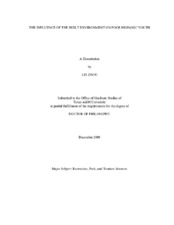| dc.description.abstract | Many studies have examined the relationship between youth physical activity
and their built environment. However, most of them used subjective measurement tools
to measure built environment because of their low cost and convenience. The
application of geographic information system (GIS) in this study greatly supported the
research in this field because it can provide more detailed objectively measured data of
built environment. Three hundred and thirty-eight Hispanic low-income youth enrolled
in a local San Antonio Youth Center program participated in the study.
The first study examined the association between youth's household income, and
the availability and accessibility of recreational and utilitarian facilities. Results
indicated that youth from low income families had longer distances to and less available
number of recreational and utilitarian facilities within their neighborhoods.
The second study focused on nutrition environmental features, such as,
availability and accessibility of fast food outlets and supermarkets. Findings suggested
that the average distance to supermarkets was almost two times that of fast food
restaurants. These results indicated that participants need to walk more to access a supermarket compared to the closest fast food restaurant. On the whole, supermarkets
were less accessible compared to fast food restaurants for the participants in the study
area.
The third study provided some important supplements to the first two studies by
examining both features related to physical activity and dietary behavior with youth's
BMI. Results indicated that the available number (availability) of physical activity- and
food-related facilities contributed significantly to youth BMI. Lower BMI was related to
more available utilitarian (e.g., shopping malls), recreational facilities (e.g., parks) and
some food stores (e.g., supermarkets).
This study indicated that youth's individual features (e.g., age and SES) had
some associations with their health conditions (e.g., BMI) and built environments (e.g.,
accessibility and availability of facilities and food outlets). These results may provide
some evidence to improve the understanding of the relationship between individual,
environmental, and social characteristics, which may be useful to promote children and
adolescent health behaviors (e.g., physical activity and eating behavior) in public health. | en |


